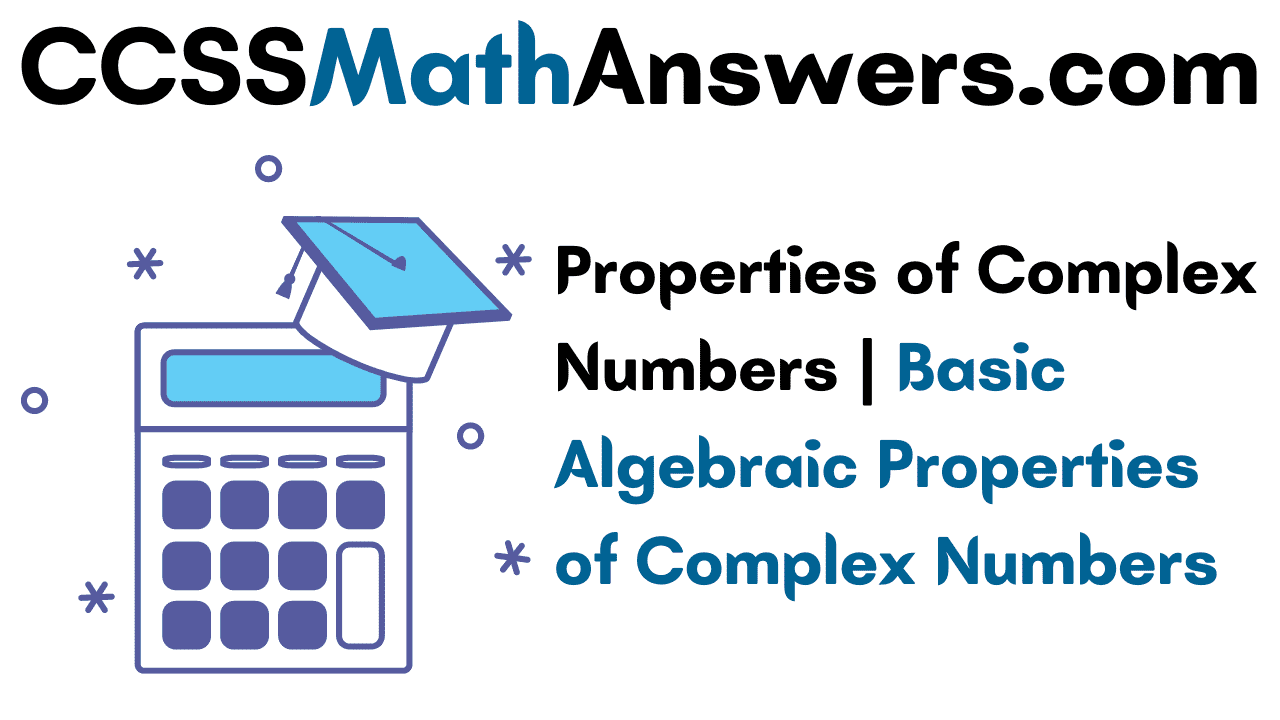Complex Number is a combination of both Real and Imaginary Numbers. In other words, Complex Numbers are defined as the numbers that are in the form of x+iy where x, y are real numbers and i =√-1.
z = x+iy here x is the real part of the Complex Number and is denoted by Re Z and y is called the Imaginary Part and is denoted as Im Z. In the later sections, you will find What is a Complex Number and Properties of Complex Numbers. We tried explaining each and every Property of Complex Number in detail with Proofs.
What are Complex Numbers?
If x, y ∈ R, then ordered pair (x, y) = x + iy is called a complex number. It is denoted by z. Where x is the real part and is denoted as Re(z) and y is the imaginary part of the complex number and represented as Im(z).
(i) If Re(z) = x = 0, then the number z is a purely imaginary number
(ii) If Im(z) = y = 0 then the number z is a purely real number.
Properties of Complex Numbers
1. If x, y are two real numbers and x+iy =0 then x = 0 and y = 0
Proof:
Since, x + iy = 0 = 0 + i0, thus by the definition of equality of two complex numbers we can say that, x = 0 and y = 0.
2. If x, y, p, q are real and x + iy = p + iq then x = p and y = q
Proof:
Given x + iy = p + iq
rearranging the equation we get x − p = -i(y − q)
⇒ (x − p)2 = i2 (y − q)2
⇒ (x − p)2 + (y − q)2 = 0 (We know i2 = -1)……..(1)
Since x, y, p, q are real, and (x − p)2 and (y − q)2 are both non-negative. Equation (1) is satisfied if each square is separately zero.
Thus we can write the equation as follows
(x − p)2 = 0 or x = p and (y − q)2 = 0 or y = q.
3. Similar to real numbers, the set of complex numbers also satisfy the commutative, associative, and distributive laws
Proof:
If z1, z2 and z3 be three complex numbers then,
z1 + z2 = z2 + z1 (commutative law of addition) and z1. z2 = z2. z1 (commutative law of multiplication)
(z1 + z2) + z3 = z1 + (z2 + z3) (associative law of addition) and (z1. z2) z3 = z1 (z2. z3) (associative law of multiplication)
z1(z2 + z3) = z1 z2 + z1 z3 (distributive law)
4. Sum and Product of Two Conjugate Complex Quantities are both Real.
Proof:
Consider z = x + iy is a complex number where x, y are real.
Then, the conjugate of z is = x − iy.
Now, z + \(\overline {z}\)= x + iy + x − iy = 2x, is real.
and z. \(\overline {z}\) = (x + iy)(x − iy) = x2 − i2y2 = x2 + y2 is also real.
5. For two complex quantities z1 and z2, |z1+ z2| ≤ |z1 | + |z2 |
Proof:
Let z1 = r1(cosθ1 + isinθ1 ) and z2 = r2(cosθ2 + isinθ2 ).
Hence |z1 | = r1 and |z2 | = r2
Now
z1 + z2 = r1(cosθ1isinθ1) + r2(cosθ2 + isinθ2)
= (r1(cosθ1+ r2cosθ2 )+ i(r1sinθ1+ r2sinθ2)
Hence |z1+ z2 | = √(r1cosθ1+ r2cosθ2)2 + (r1sinθ1+ r2sinθ2)2
= √r12(cos2θ1+ sin21) + r22(cos2θ2+ sin2θ2) + 2r1r2 (cosθ1 cosθ2+ sinθ1 sinθ2)
= √r12 + r22 + 2r1r2cos (θ1– θ2)
Now, |cos(θ1– θ2)| ≤ 1
Hence |z1+ z2| ≤ √r12 + r22 + 2r1r2 or |z1+ z2 | ≤ |z1| + |z2 |
6. If the sum of two complex numbers is real and the product of two complex numbers is also real then the complex numbers are conjugate to each other.
Proof:
Let us consider z1 = a + ib and z2 = c + id are two complex quantities (a, b, c, d and real and b ≠ 0, d ≠0).
As per the property,
z1 + z2 = a+ ib + c + id = (a + c) + i(b + d) is real.
Therefore, b + d = 0
⇒ d = -b
and,
z1.z2 = (a + ib)(c + id) = (a + ib)(c +id) = (ac – bd) + i(ad + bc) is real.
Therefore, ad + bc = 0
⇒ -ab + bc = 0, (Since, d = -b)
⇒ b(c – a) = 0
⇒ c = a (Since, b ≠ 0)
Hence, z2 = c + id = a + i(-b) = a – ib
Thus, we can say that z1 and z2 are conjugate to each other.
